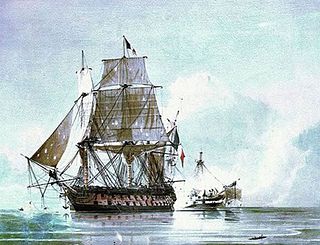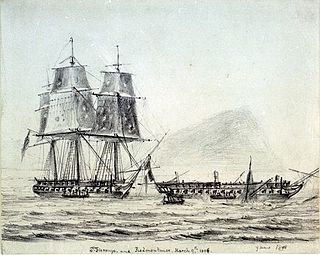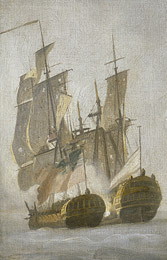
HMS Leander was a Portland-class 50-gun fourth rate of the Royal Navy, launched at Chatham on 1 July 1780. She served on the West Coast of Africa, West Indies, and the Halifax station. During the French Revolutionary Wars she participated in the Battle of the Nile before a French ship captured her. The Russians and Turks recaptured her and returned her to the Royal Navy in 1799. On 23 February 1805, while on the Halifax station, Leander captured the French frigate Ville de Milan and recaptured her prize, HMS Cleopatra. On 25 April 1805, cannon fire from Leander killed an American seaman while Leander was trying to search an American vessel off the US coast for contraband. The resulting "Leander affair" contributed to the worsening of relations between the United States and Great Britain. In 1813, the Admiralty converted Leander to a hospital ship under the name Hygeia. Hygeia was sold in 1817.

HMS Phaeton was a 38-gun, Minerva-class fifth rate of Britain's Royal Navy. This frigate was most noted for her intrusion into Nagasaki harbour in 1808. John Smallshaw built Phaeton in Liverpool between 1780 and 1782. She participated in numerous engagements during the French Revolutionary Wars and the Napoleonic Wars during which service she captured many prizes. Francis Beaufort, inventor of the Beaufort Wind-Scale, was a lieutenant on Phaeton when he distinguished himself during a successful cutting out expedition. Phaeton sailed to the Pacific in 1805, and returned in 1812. She was finally sold on 26 March 1828.

HMS Latona was a 36-gun, fifth-rate frigate of the Royal Navy that served during the American Revolutionary War, the French Revolutionary Wars, and the Napoleonic Wars. Shortly after her launch in 1781, she participated in the Battle of Dogger Bank against a Dutch squadron in the North Sea. In September 1782, Latona took part in the relief of Gibraltar and was the first ship in the convoy to pass through the Straits, when Richard Howe sent her ahead, to spy on the condition of the Franco-Spanish fleet in Algeciras Bay.
HMS Unicorn was a 28-gun Lyme-class sixth-rate frigate of the Royal Navy. She was originally ordered as a 24-gun ship to the draft of the French privateer Tyger. The third vessel of the Royal Navy to bear the name, Unicorn, as well as HMS Lyme which was a near-sister, were the first true frigates built for the Royal Navy. They were actually completed with 28 guns including the four smaller weapons on the quarterdeck, but the latter were not included in the ship's official establishment until 22 September 1756. The two ships differed in detail, Unicorn having a beakhead bow, a unicorn figurehead, two-light quarter galleries, and only five pairs of quarterdeck gunports, while Lyme had a round bow, a lion figurehead, three-light quarter galleries, and six pairs of quarterdeck gunports.

HMS Lively was a 20-gun post ship of the Royal Navy, launched in 1756. During the Seven Years' War she captured several vessels, most notably the French corvette Valeur in 1760. She then served during the American Revolutionary War, where she helped initiate the Battle of Bunker Hill. The French captured her in 1778, but the British recaptured her in 1781. She was sold in 1784.
Five ships of the Royal Navy have borne the name HMS Flora:

HMS Active was a Royal Navy fifth-rate frigate launched on 14 December 1799 at Chatham Dockyard. Sir John Henslow designed her as an improvement on the Artois-class frigates. She served during the French Revolutionary Wars and the Napoleonic Wars, capturing numerous enemy vessels. Her crews participated in one campaign and three actions that would later qualify them for the Naval General Service Medal. She returned to service after the wars and finally was broken up in 1860.

HMS Mermaid was a 32-gun Active-class fifth-rate frigate of the Royal Navy, launched in 1784 and broken up in 1815. During the French Revolutionary Wars she served in the West Indies, the Channel, and the Mediterranean. During the Napoleonic Wars she first served in the Americas, but from early 1811 on, she was armed en flute and served as a troopship until she was broken up.

Bonne Citoyenne was a 20-gun corvette of the French Navy launched in 1794, the name ship of a four-vessel class. She was part of the French fleet active in the Bay of Biscay and English Channel. The Royal Navy captured her in 1796, commissioning her as the sloop-of-war HMS Bonne Citoyenne.

HMS Ambuscade was a 32-gun fifth-rate frigate of the Royal Navy, built in the Grove Street shipyard of Adams & Barnard at Depford in 1773. The French captured her in 1798 but the British recaptured her in 1803. She was broken up in 1810.

HMS Lowestoffe was a 32-gun fifth-rate frigate of the Royal Navy. Built during the latter part of the Seven Years' War, she went on to see action in the American War of Independence and the French Revolutionary War, and served often in the Caribbean. A young Horatio Nelson served aboard her shortly after passing his lieutenant's examination.

Minerve was a 40-gun frigate of the French Navy, lead ship of her class. She operated in the Mediterranean during the French Revolutionary Wars. Her crew scuttled her at Saint-Florent to avoid capture when the British invaded Corsica in 1794, but the British managed to raise her and recommissioned her in the Royal Navy as the 38-gun fifth rate HMS St Fiorenzo.
HMS Montreal was a 32-gun Niger-class fifth-rate frigate of the Royal Navy. She was launched in 1761 and served in the Seven Years' War and the American War of Independence. The French captured her in 1779 and she then served with them under the name Montréal. An Anglo-Spanish force destroyed her during the occupation of Toulon early in the French Revolutionary Wars.

HMS Fox was a 28-gun Enterprise-class sixth-rate frigate of the Royal Navy. Fox was first commissioned in October 1775 under the command of Captain Patrick Fotheringham. The Americans captured her in June 1777, only to have the British recapture her about a month later. The French then captured her a little less than a year after that, only to lose her to grounding in 1779, some six months later.

HMS Minerva was one of the four 32-gun Southampton-class fifth-rate frigates of the Royal Navy. She was launched in 1759 and served through the Seven Years' War, but was captured in 1778 during the American Revolutionary War and served as the French Minerve until being recaptured in 1781 and renamed HMS Recovery. She was broken up in 1784.

HMS Cambrian was a Royal Navy 40-gun fifth-rate frigate. She was built and launched at Bursledon in 1797 and served in the English Channel, off North America, and in the Mediterranean. She was briefly flagship of both Admiral Mark Milbanke and Vice-Admiral Sir Andrew Mitchell during her career, and was present at the Battle of Navarino. Cambrian was wrecked off the coast of Grabusa in 1828.

HMS Nymphe was a fifth-rate frigate of the British Royal Navy, formerly the French Nymphe, lead ship of her class. HMS Flora, under the command of Captain William Peere Williams, captured Nymphe off Ushant on 10 August 1780. Indiscriminately referred to as Nymph, Nymphe, La Nymph or La Nymphe in contemporary British sources, she served during the American, French Revolutionary and Napoleonic Wars. On 19 May 1793, while under the command of Captain Edward Pellew, she captured the frigate Cléopâtre, the first French warship captured in a single-ship action of the war. After a long period of service in which she took part in several notable actions and made many captures, Nymphe was wrecked off the coast of Scotland on 18 December 1810.

HMS Clyde was a Royal Navy Artois-class frigate built at Chatham Dockyard of fir, and launched in 1796. In 1797, she was one of only two ships whose captains were able to maintain some control over their vessels during the Nore mutiny. In 1805, HMS Clyde was dismantled and rebuilt at Woolwich Dockyard; she was relaunched on 23 February 1806. She was ultimately sold in August 1814.
Two vessels of the Royal Navy have borne the name, HM galley Pigot. Both were acquired in 1778 during the American Revolutionary War, and both were lost that year; her crew destroyed the first to avoid her capture, and the Americans captured the second. Both were named for General Sir Robert Pigot, the general commanding the British Army at Newport, Rhode Island, during their service there.
HMS Stag was a 32-gun fifth-rate frigate built for the Royal Navy. She was ordered in 1790 and work began in March 1792 at Chatham Docks. Completed in August 1794, Stag spent much of her service in home waters, where she worked to protect British shipping from French privateers. In an action on 22 August 1795, Stag engaged, and forced the surrender of, the Dutch frigate Alliante, and took part in the chase that ended with the capture of Bonne Citoyenne by HMS Phaeton on 10 March 1796.
















